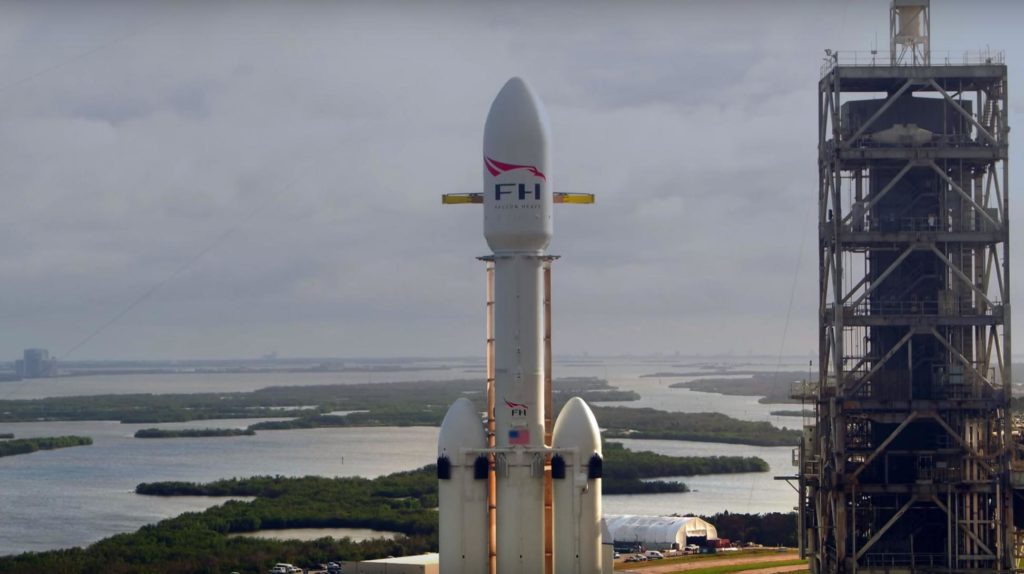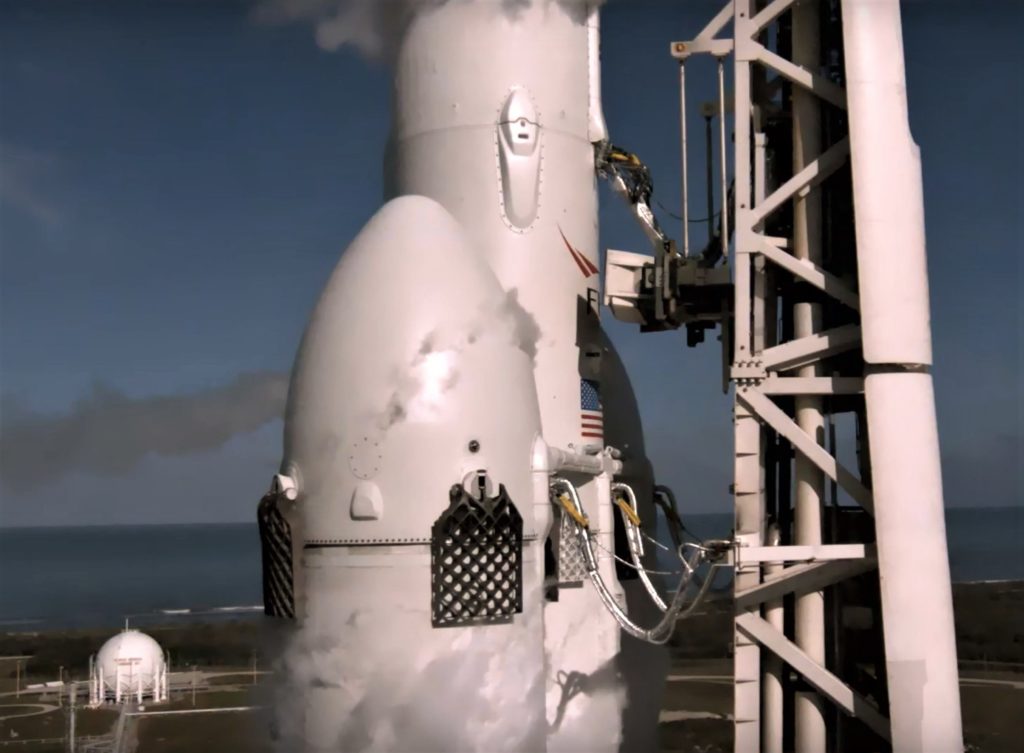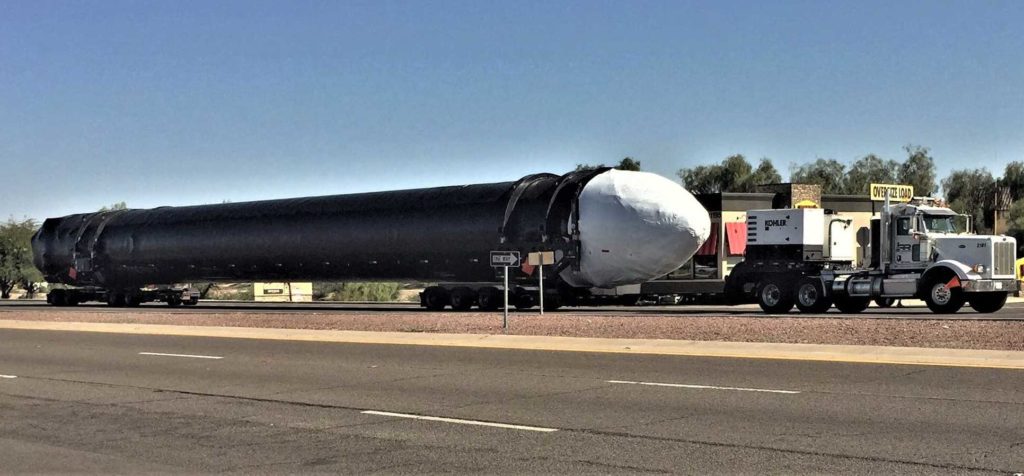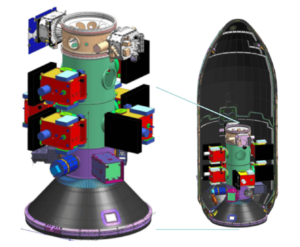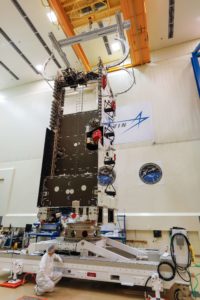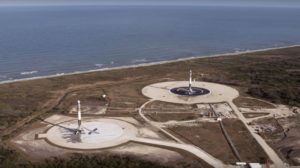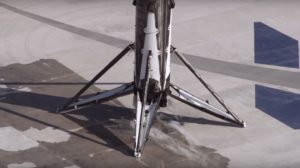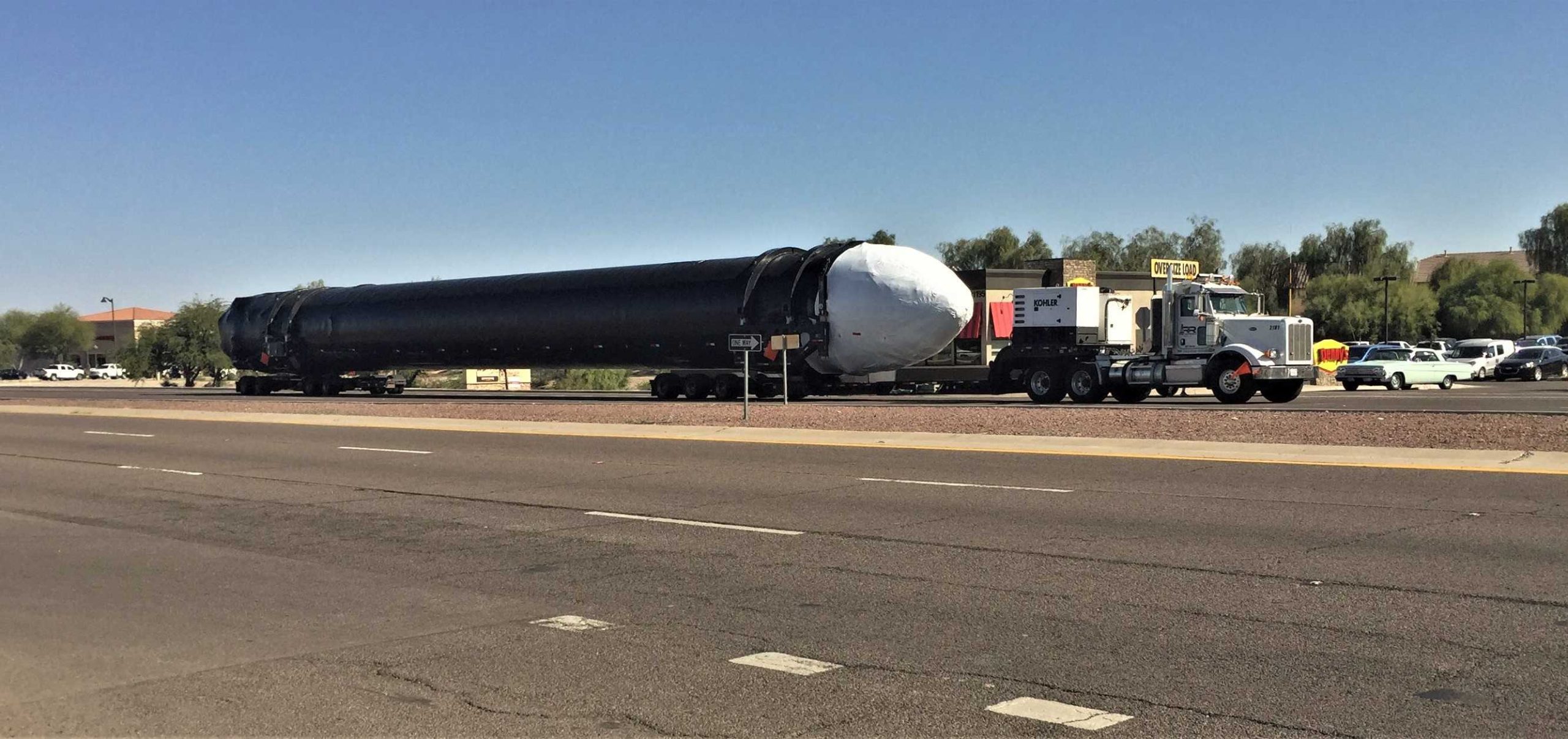
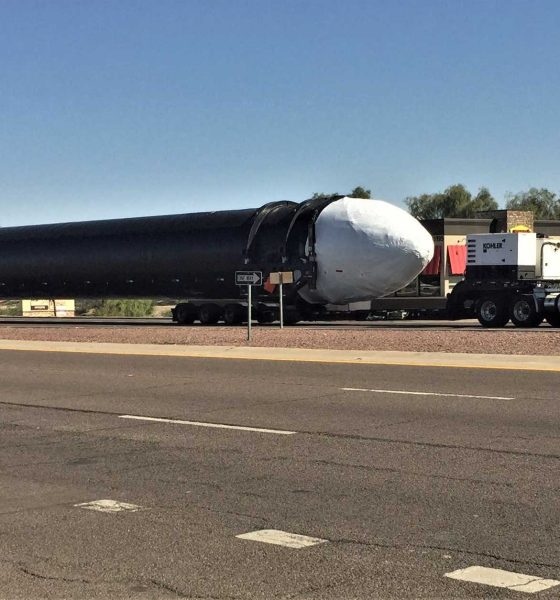
News
SpaceX’s next-gen Falcon Heavy closer to reality as side booster leaves factory
A duo of rocket spottings on November 9th and 10th confirm that SpaceX’s next Falcon Heavy rocket – an amalgamation of three Falcon 9 boosters, an upper stage, and extensive modifications – is already in the late stages of manufacturing and is nearing the beginning of integrated structural and static fire testing.
As of now, this Falcon Heavy side booster could end up supporting either or both of two near-term launch contracts in place for the rocket, communications satellite Arabsat 6A or the US Air Force’s second Space Test Program (STP-2) launch
SpaceX's second Falcon Heavy is slowly but surely coming together 😀 https://t.co/AYJsQ8Mld5
— Eric Ralph (@13ericralph31) November 13, 2018
The question of the hour – at least for Falcon Heavy – is which of those two available payloads will be atop the rocket on its first truly commercial launch. While suboptimal, a few general characteristics of each payload, SpaceX’s history of commercial launches, and Falcon Heavy itself can offer a hint or two.
Triple the rocket, triple the trouble
Thanks in large part to the fact that the first integrated Falcon Heavy was composed of two relatively old Falcon 9 booster variants and a center core that was quite literally a one-off rocket, the process of reenginering and building another Falcon Heavy rocket off of the family’s newest Block 5 variant has likely been far harder than simply building another Falcon Heavy. Although all three original Falcon Heavy boosters (B1023, B1025, and B1033) were in the same league as Block 5, their Block 2 and Block 3 hardware was designed for approximately 10% less thrust and are almost entirely different vehicles from the perspective of structures and avionics.
Perhaps even more importantly, it’s unknown whether Falcon Heavy Block 1 (for lack of a better descriptor) was designed with serious reusability in mind, at least in the same sense as Falcon 9 Block 5 was. For instance, a major portion of the rocket’s extreme complexity and difficulties lies in the basic need to transmit three times as much thrust through the center core. To do that and do it without rocket-powered separation mechanisms, SpaceX had to develop structural attachments and connections capable of surviving unbelievable mechanical and thermal stresses for minutes on end.
- The first Falcon Heavy was a Frankenstein’s monster of sorts. (SpaceX)
- Falcon Heavy is seen here lifting off during its spectacular launch debut. (SpaceX)
- A Falcon Heavy side booster was spotted eastbound in Arizona on November 10th. (Reddit – beast-sam)
Clearly, this was an unfathomably difficult problem to solve in such a manner that Falcon Heavy would work at all the first time. Factor in the strategic need for those same components to survive repeated cycles of those stresses with minimal refurbishment in between and the problem at hand likely becomes a magnitude more difficult, at least. In large part, this helps to explain why there will end up being a minimum of 11-12 months between Falcon Heavy’s first and second launches.
Arabsat or STP?
Over the course of SpaceX’s last 2-3 years of commercial launch activity, the company and its customers have demonstrated time and time again a reliable pattern: commercial customers (in the sense of private entities) are far more willing to take risks with new technologies than SpaceX’s government customers. NASA’s Commercial Resupply Services is the exception for the latter group but also has no Falcon Heavy launch contracts. For Falcon Heavy, there are thus main three options at hand.
- Arabsat 6A launches first with 1-2 flight-proven boosters; the Air Force’s STP-2 mission flies on an all-new Falcon Heavy 4-6 months later.
- SpaceX builds entirely new Falcon Heavy rockets for both customers, requiring four new side boosters and two new center cores.
- STP-2 launches first on an all-new Falcon Heavy; Arabsat 6A launches second on the first flight-proven Falcon Heavy after 6+ months of additional delays.
- The USAF’s STP-2, a combination of a few dozen different satellites. (USAF)
- The communications satellite Arabsat-6A. (Lockheed Martin)
- LZ-1 and LZ-2, circa February 2018. (SpaceX)
- A closeup of one of Falcon Heavy’s side boosters after landing. (SpaceX)
Arabsat is far more likely to accept – for a significant discount – a ride aboard the first flight-proven Falcon Heavy, especially if it means preventing more major launch delays. If the Falcon Heavy side booster spotted eastbound last week is a refurbished Block 5 booster rather than a new rocket, than option 1 is the easy choice for most probable outcome. The real pack leader for Falcon Heavy Flight 2, however, will be the completion of a new Block 5 center core and its shipment to Texas for structural and static fire testing.
Time will tell. For now, a completed Falcon Heavy side booster is the best sign yet that SpaceX may manage the rocket’s second launch in the first quarter of 2019, whichever launch that may be.

Elon Musk
Elon Musk’s X will start using a Tesla-like software update strategy
The initiative seems designed to accelerate updates to the social media platform, while maintaining maximum transparency.

Elon Musk’s social media platform X will adopt a Tesla-esque approach to software updates for its algorithm.
The initiative seems designed to accelerate updates to the social media platform, while maintaining maximum transparency.
X’s updates to its updates
As per Musk in a post on X, the social media company will be making a new algorithm to determine what organic and advertising posts are recommended to users. These updates would then be repeated every four weeks.
“We will make the new 𝕏 algorithm, including all code used to determine what organic and advertising posts are recommended to users, open source in 7 days. This will be repeated every 4 weeks, with comprehensive developer notes, to help you understand what changed,” Musk wrote in his post.
The initiative somewhat mirrors Tesla’s over-the-air update model, where vehicle software is regularly refined and pushed to users with detailed release notes. This should allow users to better understand the details of X’s every update and foster a healthy feedback loop for the social media platform.
xAI and X
X, formerly Twitter, has been acquired by Elon Musk’s artificial intelligence startup, xAI last year. Since then, xAI has seen a rapid rise in valuation. Following the company’s the company’s upsized $20 billion Series E funding round, estimates now suggest that xAI is worth tens about $230 to $235 billion. That’s several times larger than Tesla when Elon Musk received his controversial 2018 CEO Performance Award.
As per xAI, the Series E funding round attracted a diverse group of investors, including Valor Equity Partners, Stepstone Group, Fidelity Management & Research Company, Qatar Investment Authority, MGX, and Baron Capital Group, among others. Strategic partners NVIDIA and Cisco Investments also continued support for building the world’s largest GPU clusters.
News
Tesla FSD Supervised wins MotorTrend’s Best Driver Assistance Award
The decision marks a notable reversal for the publication from prior years, with judges citing major real-world improvements that pushed Tesla’s latest FSD software ahead of every competing ADAS system.

Tesla’s Full Self-Driving (Supervised) system has been named the best driver-assistance technology on the market, earning top honors at the 2026 MotorTrend Best Tech Awards.
The decision marks a notable reversal for the publication from prior years, with judges citing major real-world improvements that pushed Tesla’s latest FSD software ahead of every competing ADAS system. And it wasn’t even close.
MotorTrend reverses course
MotorTrend awarded Tesla FSD (Supervised) its 2026 Best Tech Driver Assistance title after extensive testing of the latest v14 software. The publication acknowledged that it had previously criticized earlier versions of FSD for erratic behavior and near-miss incidents, ultimately favoring rivals such as GM’s Super Cruise in earlier evaluations.
According to MotorTrend, the newest iteration of FSD resolved many of those shortcomings. Testers said v14 showed far smoother behavior in complex urban scenarios, including unprotected left turns, traffic circles, emergency vehicles, and dense city streets. While the system still requires constant driver supervision, judges concluded that no other advanced driver-assistance system currently matches its breadth of capability.
Unlike rival systems that rely on combinations of cameras, radar, lidar, and mapped highways, Tesla’s FSD operates using a camera-only approach and is capable of driving on city streets, rural roads, and freeways. MotorTrend stated that pure utility, the ability to handle nearly all road types, ultimately separated FSD from competitors like Ford BlueCruise, GM Super Cruise, and BMW’s Highway Assistant.
High cost and high capability
MotorTrend also addressed FSD’s pricing, which remains significantly higher than rival systems. Tesla currently charges $8,000 for a one-time purchase or $99 per month for a subscription, compared with far lower upfront and subscription costs from other automakers. The publication noted that the premium is justified given FSD’s unmatched scope and continuous software evolution.
Safety remained a central focus of the evaluation. While testers reported collision-free operation over thousands of miles, they noted ongoing concerns around FSD’s configurable driving modes, including options that allow aggressive driving and speeds beyond posted limits. MotorTrend emphasized that, like all Level 2 systems, FSD still depends on a fully attentive human driver at all times.
Despite those caveats, the publication concluded that Tesla’s rapid software progress fundamentally reshaped the competitive landscape. For drivers seeking the most capable hands-on driver-assistance system available today, MotorTrend concluded Tesla FSD (Supervised) now stands alone at the top.
News
Elon Musk’s Grokipedia surges to 5.6M articles, almost 79% of English Wikipedia
The explosive growth marks a major milestone for the AI-powered online encyclopedia, which was launched by Elon Musk’s xAI just months ago.

Elon Musk’s Grokipedia has grown to an impressive 5,615,201 articles as of today, closing in on 79% of the English Wikipedia’s current total of 7,119,376 articles.
The explosive growth marks a major milestone for the AI-powered online encyclopedia, which was launched by Elon Musk’s xAI just months ago. Needless to say, it would only be a matter of time before Grokipedia exceeds English Wikipedia in sheer volume.
Grokipedia’s rapid growth
xAI’s vision for Grokipedia emphasizes neutrality, while Grok’s reasoning capabilities allow for fast drafting and fact-checking. When Elon Musk announced the initiative in late September 2025, he noted that Grokipedia would be an improvement to Wikipedia because it would be designed to avoid bias.
At the time, Musk noted that Grokipedia “is a necessary step towards the xAI goal of understanding the Universe.”
Grokipedia was launched in late October, and while xAI was careful to list it only as Version 0.1 at the time, the online encyclopedia immediately earned praise. Wikipedia co-founder Larry Sanger highlighted the project’s innovative approach, noting how it leverages AI to fill knowledge gaps and enable rapid updates. Netizens also observed how Grokipedia tends to present articles in a more objective manner compared to Wikipedia, which is edited by humans.
Elon Musk’s ambitious plans
With 5,615,201 total articles, Grokipedia has now grown to almost 79% of English Wikipedia’s article base. This is incredibly quick, though Grokipedia remains text-only for now. xAI, for its part, has now updated the online encyclopedia’s iteration to v0.2.
Elon Musk has shared bold ideas for Grokipedia, including sending a record of the entire knowledge base to space as part of xAI’s mission to preserve and expand human understanding. At some point, Musk stated that Grokipedia will be renamed to Encyclopedia Galactica, and it will be sent to the cosmos.
“When Grokipedia is good enough (long way to go), we will change the name to Encyclopedia Galactica. It will be an open source distillation of all knowledge, including audio, images and video. Join xAI to help build the sci-fi version of the Library of Alexandria!” Musk wrote, adding in a later post that “Copies will be etched in stone and sent to the Moon, Mars and beyond. This time, it will not be lost.”
